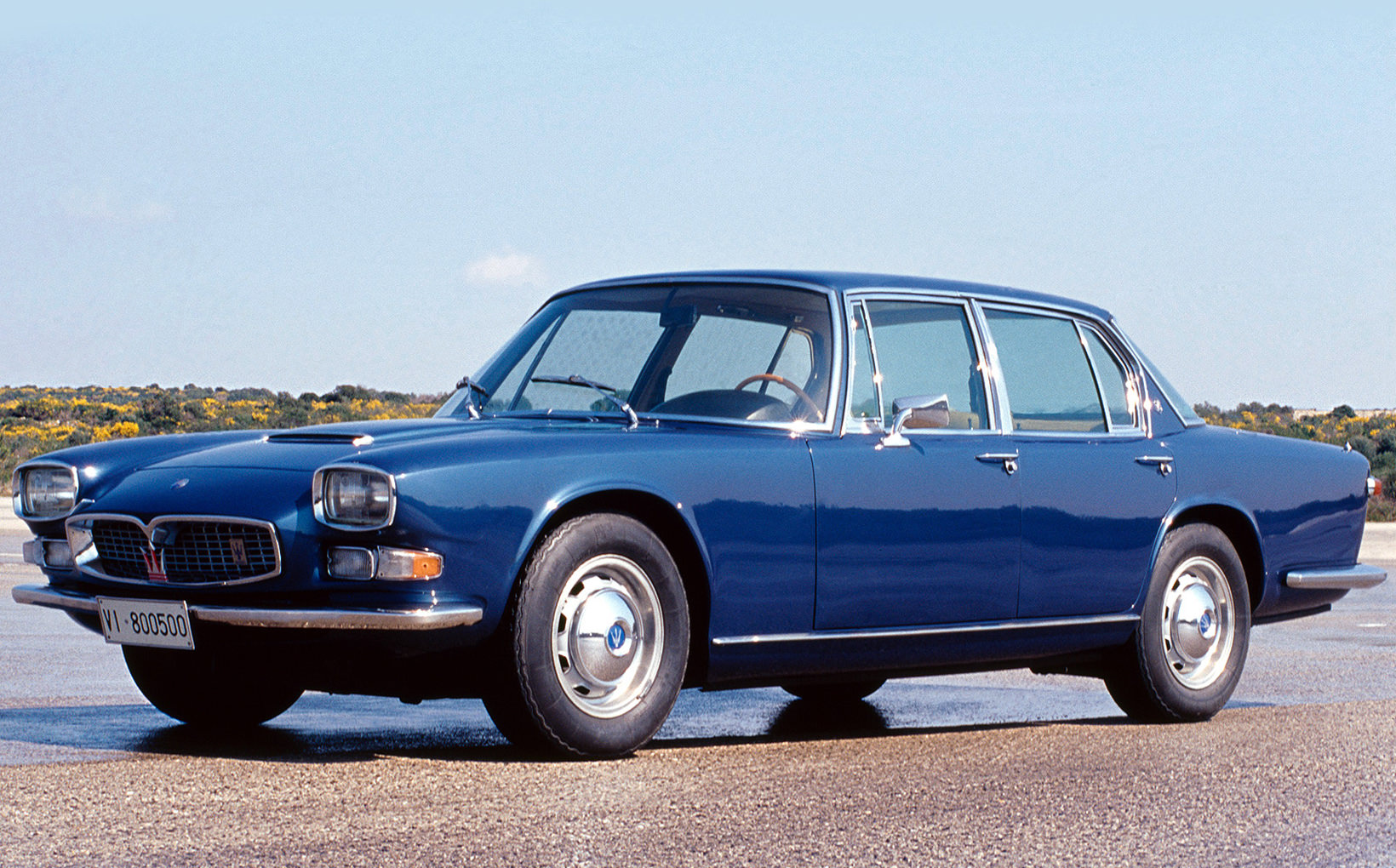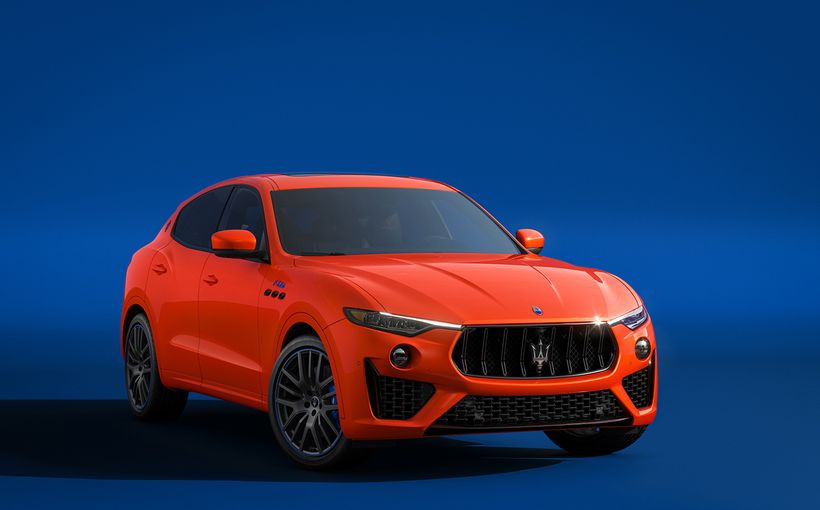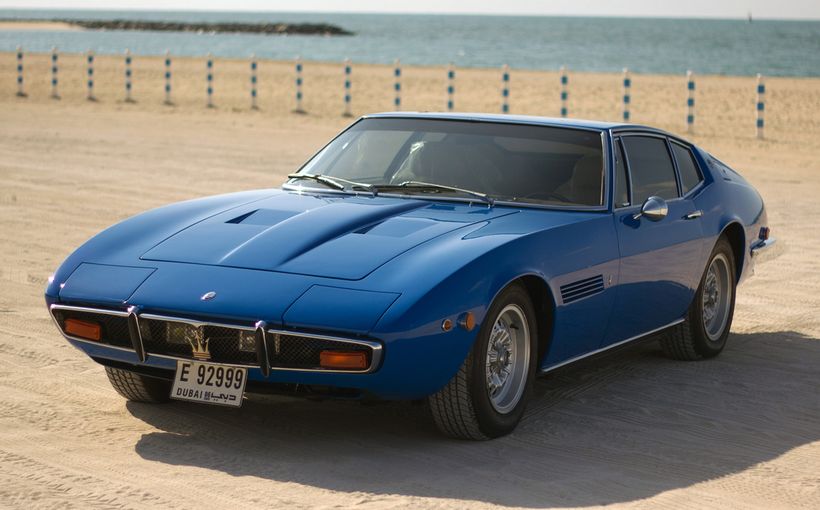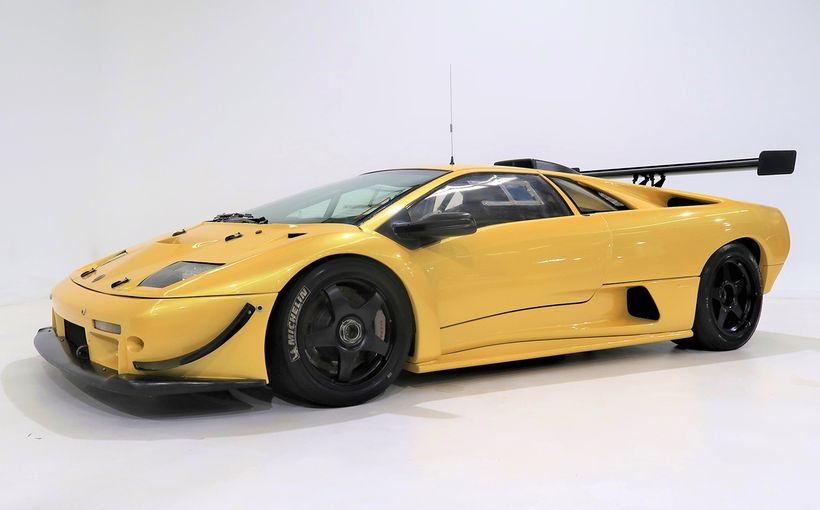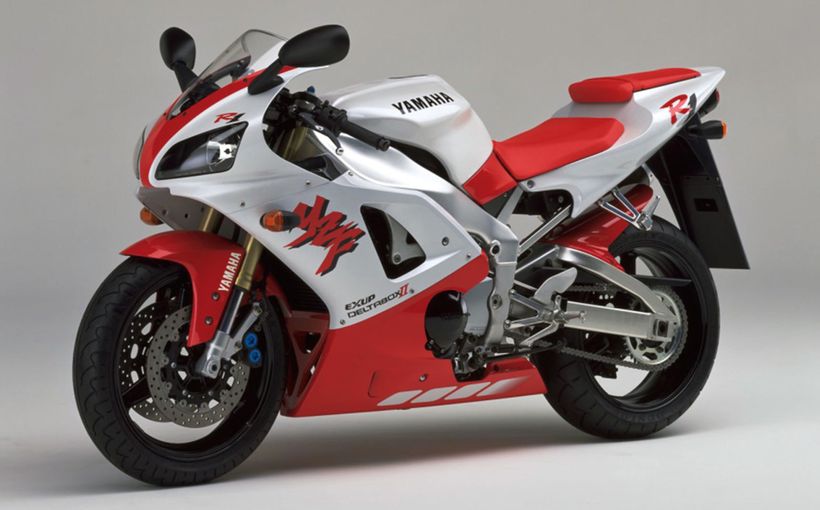Maserati Quattroporte: Translating ‘four-door’ into automotive music

Nineteen sixty-three was such a momentous year for new cars – Mercedes-Benz 600 and 230SL, Triumph and Rover 2000s, Jaguar S-Type, Hillman Imp, Chevrolet Corvette Stingray, Buick Riviera, etc – that it is no surprise to find that the Maserati Quattroporte had to wait until page 105 of Automobile Year 11 for a mention. The caption accompanying the image reads:
Maserati’s 1963 surprise was their first-ever four-door saloon, with coachwork by Frua. Powered by a 260bhp 4136 cc V8 engine, the commodious 140 four-seater had De Dion rear suspension.
So, no mention of the new ‘Quattroporte’ name. Over the decades since the first-gen model appeared, many have scoffed at the idea of simply calling a car the ‘Four-Door’, chief among them Jeremy Clarkson in his excoriating review of the Quattroporte IV for Top Gear. As an owner of precisely one of these Maseratis myself, I have been known to chuckle at the nomenclature. But when you consider what the true significance of the sub-brand is, you may be less inclined to poke fun. Besides, how much more euphonious does ‘Quattroporte’ sound than ‘Four-Door’? When the car was introduced to the public at the 1963 Turin Salon, it was called the ‘Vettura Berlina 4 Porte (Tipo AM 107).
According to Maserati, the Tipo AM 107 amounted to a whole new category of car, one that combined the attributes of a Gran Turismo coupe and a four-seater luxury sedan. Interestingly, for decades after the Quattroporte I’s debut, there was musing about the prospects of a four-door Ferrari or Porsche; sadly, the advent of the SUV era has put an end to such niceties of speculation – who, as late as the opening years of this century, could ever have predicted the Bentley Bentayga and the Rolls-Royce Cullinan?

Image: https://en.wheelsage.org/
The Maserati Quattroporte was undoubtedly the fastest production sedan in the 1963 world, ahead of the ultra-rare Lagonda Rapide, Jaguar Mark 2 3.8 and others. In a stroke of near-genius, the car received the lightweight quad-camshaft, quad-carburettorV8 engine first seen in the 450 S (of which just 10 were made) and then in the 5000 GT. In its 450 S application, the 4.2-litre unit produced 420 brake horsepower and endowed the sports-racer with a top speed of 310km/h. The 450 S fared so fantastically in the 1956 and 1957 racing seasons that no lesser luminary than the Shah of Persia asked Maserati to create a car for him with one of these V8 engines in order that he would be the owner of the world’s most powerful coupe. Thus, Maserati created the wonderful 5000 GT with a five-litre, fuel-injected 340-bhp edition of the 450 S engine.
But before the 1963 Turin Salon, no-one seems to have predicted that the famous engine might power a four-door sedan to rival a Bentley or Lagonda in luxury, while equalling an E-Type Jaguar on every attribute of performance, including top speed: Jaguar claimed 240km/h but the reality was 230 or maybe a fraction less! For further context, the Porsche 356 Carrera 2 could achieve 200 and the Ferrari 250 GT Lusso 250.
Maserati incorporated cylinder liners and shortened the stroke to reduce the capacity from 4941cc to 4136 because the Quattroporte was not to be the equal of the 5000 GT. Peak power dropped from 340 to 260 brake horsepower. Maximum revs declined from 5800 to 5500. Additionally, Maserati engineers under the direction of Giulio Alfieri replaced the 5000 GT’s cantankerous Lucas injection with a quartet of twin-choke downdraft Weber 38 DCNL 5 carburettors.
A number of design themes and details used in the Quattroporte I were retained through several generations of the model. Pietro Frua and his Studio Tecnico designed a discreet, understated body. Looking in the mirror, a driver imminently to be overtaken, would have struggled to identify this car as a Maserati. Just a trident emblem in the lower part of the grille and a small round badge above the grille declare the car’s brand identity. From behind, cursive Maserati and Quattroporte words appear on the left and right sides of the boot lid. (Such discreet branding certainly applies to my 1995 Quattroporte IV with no Maserati brand name to be seen on the exterior and just a trident badge in the grille; people often ask me what kind of car it is.)
The standard transmission was a ZF five-speed manual with dogleg first, but a Borg-Warner three-speed automatic was also available. Power steering was not standard but could be specified. The redoubtable Belgian racing driver and journalist Paul Frère road tested a Quattroporte I for the spring 1965 edition of Motor-Review and mentioned the steering in the context of quite high praise:
Despite Giulio Alfieri’s best efforts, the Maserati still cannot hide its sporting roots, and although very comfortable, is more firmly sprung than a Mercedes or Jaguar and is not (or rather isn’t yet) as refined. The noise of the powerful engine and the contact with the road can be heard in the cabin, although the car’s performance is superior to its rivals. The car we tried didn’t have the optional ZF power steering which we would advise owners to opt for, because five and a half turns lock to lock, even with a good 13-metre turning circle, are excessive for a car this fast.
To italicise ‘this fast’, Frère measured zero to 100km/h in 8.6 seconds, 0-160km/h in 21.6 seconds (I recall the 1965 Thunderbird 390-engined Ford Galaxie took 28 in a Wheels road test!) and the standing kilometre in 29.2.
The body was mounted on a boxed steel chassis. Suspension was by wishbones and coils up front and the rear used a de Dion rear axle (like the contemporaneous Rover 2000) with Watts Linkage and coils. Girling disc brakes were fitted all round, with the rears mounted inboard adjacent to the differential. Pirelli Cinturatos of 205 width were fitted to steel wheels. The Quattroporte – in a first (at least for a European manufacturer) – was equipped with air-conditioning.
In 1964-65, Maserati made 260 of these cars. Ten colours were available: four shades of grey, blue, black, Bordeaux, god, volpe argentata (silver wolf) and luci di mezzanotte (midnight lights). It is believed that a significant proportion of these cars remain in the custody of the original owner or family.

Image: https://en.wheelsage.org/

Image: https://www.classic-trader.com/
From November 1965, a more powerful 4.7-litre edition, known as the Quattroporte I Series 2, AM 107/A replaced the original. Visually, it was distinguished by four round headlights. The capacity increase came from taking the bore from 88 to 93.9mm while retaining the 85mm stroke. Peak power leapt to 290hp at 5500rpm. This formidable machine could reach 240km/h under ideal conditions.

Image: https://en.wheelsage.org/
The impressively sophisticated de Dion rear end made way for a more rudimentary live axle. In a lengthy technical review in the November 1996 edition, Autocar mused about this apparently retrograde step:
The sturdy de Dion layout was probably abandoned because it weighed as much as a live axle with leaf springs. Or perhaps because it was difficult to filter out road noise transmitted via the rigid mounting points of the differential on the axle. In any case, the live axle solution provides significant advantages in terms of simplicity of construction and sound-proofing.
In their commissioned history of the Maserati Quattroporte (Maserati Quattroporte: the History), Jürgen Lewandowski and Ermanno Cozza write:
Naturally, the English magazine had no idea of the real reasons…Full marks to Autocar for the accuracy of its analysis. In fact, Maserati had realised that 99 per cent of its clients did not actually see the Quattroporte as the heir to the 450 S track car and would have preferred the reassuring comfort of a more conventional suspension system to the sophisticated by uncompromising de Dion one.
It is interesting to see how the first-gen model was received in the home of the high-compression V8 engine, the US. Car and Driver (September 1967) opined:
We are not sure the Maserati Quattroporte is the car for you, unless of course you are a fancier of unabashedly unique and well-bred cars…A four-cam, five-speed, five-digit Wonder Wagon that will zoom you up, up, up the social ladder as fast as a Lear jet.

Image: https://en.wheelsage.org/
From the late 1960s until the late 1970s, the Maserati Quattroporte became rare almost to the point of extinction. Two only Frua models (Quattroporte Frua, Tipo AM 121) were created for private customers, the first being the aforementioned Aga Khan looking to update his 5000 GT. Pietro Frua showed his fabulous Tipo AM 121 at the 1971 Paris Salon and subsequently at Geneva in March 1972. The aluminium-bodied Quattroporte Frua was sometimes called ‘the Italian answer to the Bentley Continental’.
In 1974 Italdesign showed its original Quattroporte Medici and two years later produced a more modest one.
It was in the early 1970s that planning began for the Quattroporte II (Tipo AM 123). This was undoubtedly a most uncomfortable era for Maserati. The first oil shock occurred in 1973. Maserati sales were in trickle mode and total employees were 400. Having been commissioned by Citroën in 1967 to develop an engine for its forthcoming SM sports car, the Modenese company found itself just months later in the ownership of the French manufacturer, which had bought 60 per cent, adding a further 15 in June 1969 and the rest in June 1971.

Image: https://en.wheelsage.org/
The bulk of Maserati’s work during these years was making SM engines. But the Khamsin which was to supersede the Ghibi was in the planning and so, too, was the Quattroporte II. Perhaps it’s just as well that this car never progressed beyond prototypes because its spirit was more Citroën than Maserati. Imagine it: a front-wheel-drive Maserati with hydro-pneumatic suspension and a 3.0-litre V6 (in spite of Maserati engineers’ advice to the contrary) to power a near-two-tonne sedan! The body was the work of Bertone and in profile the QII has elements of the 1979 Ford Falcon XD. But when on 23 March 1975, Citroën announced the liquidation of Maserati, this spelt the end of the second-gen car.

Image: https://en.wheelsage.org/
In August 1975, Alejandro De Tomaso acquired Maserati. Perhaps inspired by his own De Tomaso Deauville, he made it a priority to relaunch the Quattroporte. He turned to Giorgetto Giugiaro. The car (Quattroporte III, Tipo AM 330) was debuted at the Turin Salon in 1979. De Tomaso was probably also thinking along Italian Bentley lines.

Image: https://en.wheelsage.org/
It was a large car, measuring 4.9 metres in length on a 2.8m wheelbase, 1.89 in width and weighing 1950kg.
The Quattroporte III became the Italian President’s official car and he doubtless enjoyed paying an official visit to Enzo Ferrari in his Maserati!

Image: https://en.wheelsage.org/
From 1987 to 1990, 53 QIII Royales were produced. With a cool-box, folding briarwood tables and several other extravagant details including what was destined to be a Maserati trademark, the oval gold-faced clock in pride of place at the dashboard’s centre, the Royale set a new high standard for Maserati luxury. Most Royales were sold in the US.

Image: https://en.wheelsage.org/
And so we arrive – via the ill-fated Biturbo models – to the Quattroporte that Maserati now effectively disowns, the more compact QIV that was essentially a reworked Biturbo with body by Marcello Gandini. Astoundingly, the authors of Maserati Quattroporte: the History (published to coincide with the launch of the QV) say, embracing the Biturbo cars and the QIII:
Naturally, enough, this model couldn’t be put on the same level as the Quattroporte I and III in terms of size, performance or sophistication. These are only mentioned here in passing, as this volume is dedicated to the true flagship Quattroportes.
Well! Undoubtedly, the 1990 Biturbo 425i I owned in 1995 was a shocker in terms of its electrics and neither was it an especially good-handling machine. But the Quattroporte IV is not only more elegant, but boasts much improved quality.

Image: Dr John Wright
In 1989 Fiat bought a 49 per cent share in Maserati and then, when De Tomaso became seriously ill at the end of January 1993, Fiat moved to take complete ownership, closing the deal on 19 May 1993. The first priority was to reimagine the four-door sedan, which would become the Quattroporte IV, styled by Marcello Gandini. It seems that the maestro’s brief was to turn his successful Ghibli coupe design into a four-door sedan: note how fast the C-pillar is, much more coupe than mid-1990s sedan!

Image: https://en.wheelsage.org/
The home market received a 300-horsepower 2.0-litre twin-turbocharged V6, while exports markets got the torquier 2.8 which made somewhat less power at 284. Transmission choice was six-speed manual or four-speed ZF automatic. By December 1995, the Quattroporte IV was also available with the Shamal coupe’s 3.2-litre V8 – with a pair of turbos, naturally, and making 326 horsepower. Maserati struck a deal with the Australian company BT-R to supply the same four-speed automatic used in contemporaneous Ford Falcons because the ZF was deemed inadequate for so much more torque.

Image: Dr John Wright

Image: Dr John Wright
In July 1997 Ferrari (a Fiat subsidiary) took a 50 per cent stake in Maserati and showed the Quattroporte Evoluzione at the Geneva Salon in March 1998; about half of the major parts had been changed. Perhaps surprisingly, the beautiful Lassale clock vanished from the dashboard (although it made a reappearance on the final 50 numbered cars, all automatics, ordered by Japanese importer Cornes and Co); could it have been that Ferrari management though such a jewel frivolous? The 2.8-litre version of the Evoluzione, when specified as an automatic, now also got the computer-controlled Australian BT-R transmission.

Image: Dr John Wright
The extent of the improvements made under Ferrari’s watch pointed to a new future for Maserati. The twin-turbocharging regime was set to disappear. Mechanically, the next two generations of Quattroporte would be essentially Ferrari. While in many respects, they were superior to the older models, the QV and QVI lost much of that unique Maserati character.

Image: https://en.wheelsage.org/
The physically bigger and heavier Quattroporte V (M 139 AQ/340) arrived in 2004. It was powered by a 395-horsepower dry-sump Ferrari 4.2-litre V8 and was available only with a rear-mounted automated manual transmission (DuoSelect), which many – probably most – enthusiasts deplored: the jerky shifts were out of keeping with the car’s otherwise smooth and urbane character. It is all but impossible to understand the product planning behind the choice to go with such a transmission and not even offer an alternative. Assorted special versions were offered, including the Executive GT, Sport GT and Sport GT S, but it was not until January 2007 at the Detroit Motor Show that a ZF six-speed torque converter automatic transmission was made available. Significantly, the first of these cars all went to the US market, named Maserati Quattroporte Automatica. You can hear the sighs of relief!

Image: https://en.wheelsage.org/
A facelifted version came in 2008. Blessedly the DuoSelect transmission was no longer to be seen. More than 25,000 QVs were manufactured so the model lacks the rarity of all predecessors including the QIV (total 2400).

Image: https://en.wheelsage.org/

Image: https://en.wheelsage.org/
The larger sixth generation car (M156) was launched in 2013, the further increase in size being due to the advent of the smaller Ghibli, which in its more sporting essence was arguably a more legitimate heir to the Quattroporte tradition.

Image: https://en.wheelsage.org/
Paradoxically, excellent as these two most recent generations of Quattroporte are – aside from the DuoSelect on earlier versions of QV – they do not seem to fit as well into the tradition of the Quattroporte as does the much-maligned QIV. The relationship of all Maseratis has moved much closer to Ferraris. By contrast, the twin-turbocharged 2.8-litre V6 and 3.2-litre V8 were pure-bred Maserati units, with the V6 owing much to the Citroën SM’s engine.
Indeed, When Citroën approached Maserati to create a new V6 engine for the SM, the engineers based this on their existing V8, minus two cylinders. And that V8’s ancestry goes back to the fabulous 450 S. The Maserati V8 story dates to 1935 when the Modenese firm produced the world’s first V8-engined Formula One car. Later, the 2.7-litre 90-degree V6 SM engine was increased to a full three litres and used in the Merak (which also had an SM dashboard!). The V6s used in the 1980s and early 1990s Biturbo range were new, but were based on this unit, which was the used in the first ‘Quattroporte’ since 1990. So, by any definition, the Quattroporte IV, was every millimetre a true Maserati!
The original 1963 Maserati Quattroporte seems more important now than perhaps it did at the time. It represented a new conception of a GT with room for four and plenty of luggage. Unlike contemporaneous Jaguars and Mercedes sedans, it retained the feel of a sports car. Here was not a kind of four-door Ferrari but emphatically a Maserati. Perhaps the imposing Quattroporte III in Royale guise represents the high point of this long series for its sheer bespoke quality, but my inclination is for the quad-headlight, 4.7-litre 1965-69 Q1 (in that magnificent scarlet shown in the second and third images accompanying this story). As the decades roll by, even the QIV will deserve increasing respect as a true Maserati with the associated flaws and foibles, rather than Ferrari’s idea of an Italian luxury sedan which pretty much sums up its QV and QVI successors.

